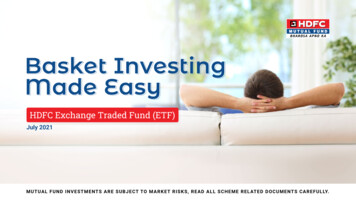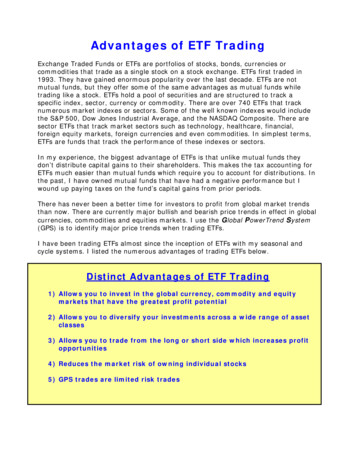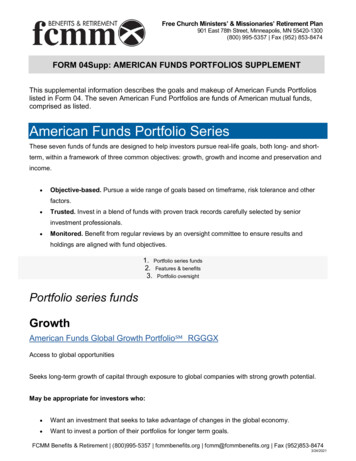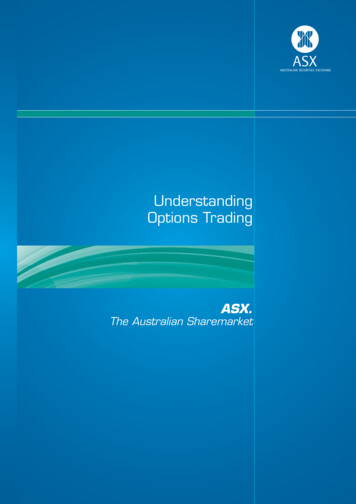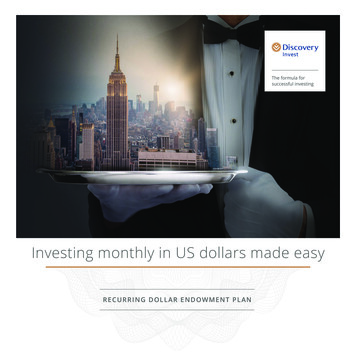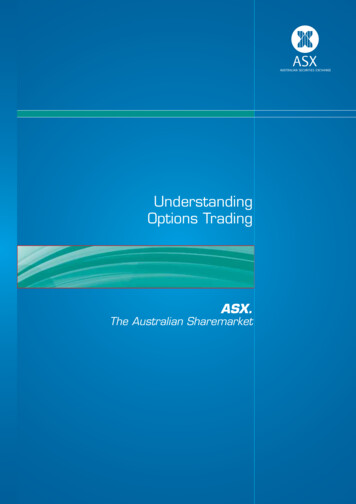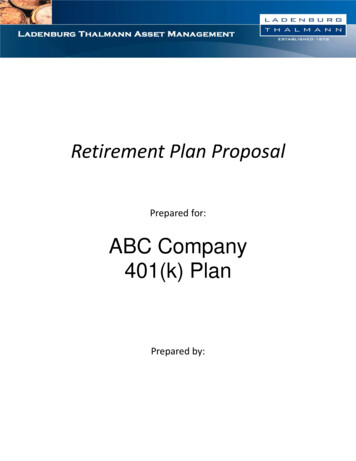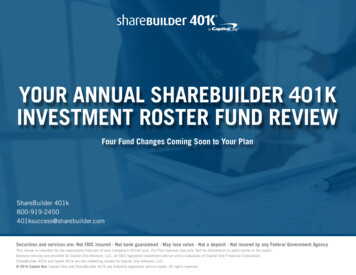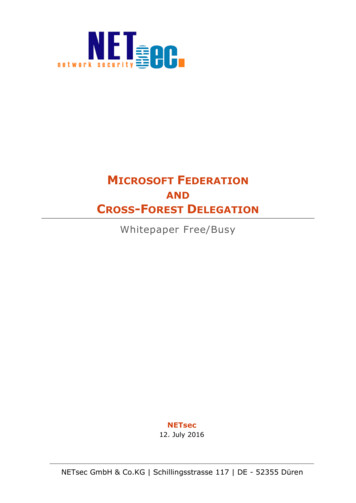
Transcription
Exchange Traded Funds Thematic Note - Findingsand Observations during COVID-19 inducedmarket stressesPublic ReportThe BoardOF THEINTERNATIONAL ORGANIZATION OF SECURITIES COMMISSIONSOR03AUGUST 2021
The unprecedented nature of the COVID-19 pandemic brought severe shock to the financial markets.At the height of the market turmoil in March and April 2020, exchange traded funds (ETFs) in variousmarkets went through a stress period. This note reviews the operation and activities of the primarymarket and secondary market of ETFs during such a period. In particular, it explores the impact of thestress on the ETF structure and functioning, including the causes of the substantial pricing differencesbetween some fixed income ETFs’ secondary market prices and their Net Asset Values (NAVs). It alsooutlines some challenging circumstances concerning some derivatives-based ETFs. The informationsources drawn on by this note include, among others: Data analysis compiled by a core research group (CRG) from IOSCO’s Committee 5 onInvestment Management (C5); Responses to a survey from 24 C5 members; and Responses to an industry survey from 49 industry participants.By examining the aforementioned, this note seeks to review the resilience of the ETF structure duringthe COVID-19 volatility. Overall, available evidence, including data analytics and feedback from C5members and industry participants, has not indicated any major risks or fragilities in the ETF structurealthough a subset of ETFs temporarily experienced unusual trading behaviors. The COVID-19 volatilityhas shed light on the resilience of most ETFs across various market segments during stressed markets.There is an emerging consensus that fixed income ETFs could provide useful pricing information to thewider market. However, a fixed income ETF’s value as a price discovery tool for the individual bonds inthe underlying portfolio remains subject to debate and ongoing research. In addition, the stress episodehelped alleviate concerns about possible financial stability risks relating to the ETF structure.Nevertheless, this note could also prove instructive in the consideration of future enhancements in ETFregulation and guidance.The first section of the note provides the background of the COVID-19 volatility. The second sectionprovides a description of how various ETF markets generally fared during the period, based on dataanalytics. The third section summarizes the initial findings and observations, supplemented by surveyresponses.1. Background – COVID-19 volatilityThe outbreak of COVID-19 and the public health measures put in place across the world to contain thespread of the pandemic led to a sudden decline in global business activity. While first and foremost ahealth crisis, the global pandemic also led to high volatility and significant stresses in financial marketsin March and April 2020. Market prices of equity and debt securities fell rapidly, yields increased acrossthe yield curve, uncertainty in the economy and asset-price volatility spiked, and bid-ask spreadswidened significantly even for high-quality and liquid government debt securities, such as US Treasurysecurities. Investors rapidly and generally shifted their risk preferences toward cash and other highlyliquid instruments.2
In response to the shock to the financial market, authorities around the world implemented a varietyof support measures which (including the effect of their announcements) had a major impact inrestoring confidence in the functioning of financial markets around the world. 1The COVID-19 pandemic, therefore, presented a real-world test for the ETF structure in response tosignificant market stress. Concerns about potential financial stability risks, linked primarily toperceived risks around the impact of primary market selling pressures onto the underlying assetmarkets such as corporate bonds, had also not been examined empirically under such conditions.2. General observations from data analyticsThe CRG for the IOSCO C5 ETF work 2 conducted data analytics work on the operations of ETFs duringthe COVID-19 stress. The timeframe of the analysis on ETFs was from Q4 2019 to Q2 2020, covering theheight of market volatility experienced in March and April 2020 before markets gradually returned tomore normal levels from May 2020 onwards. In addition, the analysis grouped ETFs based on theirunderlying asset classes (i.e., equities, government bonds, investment-grade (IG) bonds and high-yield(HY) bonds) 3 and geographical regions / listing venues (i.e., US, Europe and Asia Pacific) to provide amore granular view of how each category of ETFs fared in different regions during the period.1These measures included (1) fiscal support measures, including tax measures, grants and subsidies,expansion of unemployment benefits, cash to household schemes, and loan programs; (2) monetarysupport measures, including expanded quantitative easing programs, reduction in key rates, and centralbank liquidity facilities; (3) financial support measures, including easing of regulatory requirements andpayment holidays (e.g., on consumer credit products and mortgages); and (4) in some instances,measures to directly support the functioning of debt security markets.2The core research group comprises Autoriteit Financiële Markten (AFM, Netherlands), Autorité desMarchés Financiers (AMF, France), Central Bank of Ireland (CBI, Ireland), European Securities andMarkets Authority (ESMA), Financial Conduct Authority (FCA, UK), Securities and Futures Commission(SFC, Hong Kong) and Securities and Exchange Commission (SEC, US).3Depending on the data sources, fund categories may not be mutually exclusive. For example, for USETFs, IG or HY bond ETF categories may include government or municipal bond ETFs.3
(i) Temporary spikes in premia/discounts to day-end NAVDay-end premium or discount to NAV is a common metric used for assessing the difference betweenan ETF’s secondary market price and its NAV. Depending on market conditions, a minimal or smallpremium or discount to NAV at close of trading day is generally expected and indicative of an effectivearbitrage mechanism while a larger difference may imply that other market factors may have had someimpact on the arbitrage mechanism. US-registered ETFs (US ETFs) 4 experienced above-average levels of premia and discounts inMarch 2020. 5 Discounts were most pronounced in fixed income ETFs, where the median ETFtraded at increased discounts for several consecutive days during March 2020. At one point,certain IG bond and HY bond ETFs in extreme cases and for a short time traded at discountlevels ranging from 6% to 10%. Markets began stabilizing in Q2 2020, and premia and discountsreverted closer to their pre-March levels. Similar trends were observed in Europe and Asia Pacific where premia and discounts widenedin March 2020. 6 The discount of the more impacted fixed income ETFs also increased to as muchas 10% at one point (e.g., IG bond ETFs in Europe). The spike in price difference was, however,short-lived and normalized shortly thereafter. Among fixed income ETFs across regions, the largest discounts were generally observed in HYbond ETFs at the height of the market volatility, followed by IG bond ETFs and governmentbond ETFs.Widened premia or discounts were generally observed across both equity and fixed income ETFs inMarch 2020. For instance, in some jurisdictions in Europe and Asia in particular, it is noted that premiaor discounts for equity ETFs could be largely attributable to trading hour differences and hencevaluation differences between the ETFs and their underlying assets. For example, in the case of an ETFlisted in Asia that tracks a US equity index, its secondary market closing price and NAV (calculated byusing US market closing prices) are valued at different time points that may be more than ten hoursapart. Therefore, the two valuations could potentially diverge because they may reflect different marketinformation, especially during increased market volatility such as in March and April 2020. For fixedincome ETFs, there were potentially additional factors in play (see discussion in section 3(i)).4US ETFs in this note are registered with the U.S. SEC under the Investment Company Act of 1940.5In March 2020, for US ETFs, the largest median discounts observed among equity ETFs, governmentbond ETFs, IG bond ETFs and HY bond ETFs were -0.5%, -0.5%, -2.0% and -2.0% respectively.6In March 2020, for European ETFs, the largest median discounts observed among equity ETFs,government bond ETFs, IG bond ETFs and HY bond ETFs were -0.2%, -0.5%, -5.4% and -3.4%respectively. For Asia Pacific ETFs, the largest median discounts observed among equity ETFs,government bond ETFs, IG bond ETFs and HY bond ETFs were -0.1%, -0.2%, -2.5% and -2.6%respectively.4
Exhibit 1 – Premium or discount to day-end NAVUS 19Jun-20May-20Apr-20Mar-20Feb-20Jan-20Median / 50th percentile10th percentile90th 20Dec-19Median / 50th percentile10th percentile90th percentileNov-19Premium/discount as % of NAV(HY bond count as % of NAV(IG bond ETFs)Oct-19Median / 50th percentile10th percentile90th 20Dec-19Nov-19Oct-19Median / 50th percentile10th percentile90th percentile6%4%2%0%-2%-4%-6%-8%-10%Premium/discount as % of NAV(Government bond t as % of NAV(Equity ETFs)6%4%2%0%-2%-4%-6%-8%-10%Source: SEC staff calculations based on data provided by Bloomberg.European ETFs 7Jun-20May-20Apr-20Mar-20Feb-20Jan-20Dec-19Median / 50th percentile10th percentile90th 20Dec-19Nov-19Median / 50th percentile10th percentile90th percentileOct-197Premium/discount as % of NAV(Government bond t as % of NAV(Equity ETFs -European equity indices)6%4%2%0%-2%-4%-6%-8%-10%Unless otherwise specified, the data shown for European ETFs in this note focus on a representativesample group, consisting of the top 30 ETFs within each category (i.e., equity ETFs and governmentbond ETFs, etc.) based on end-2019 NAV to simplify the data collection exercise in respect of the morefragmented European ETF markets. Accordingly, for the premium / discount to NAV of Europeanequity ETFs, the sample group excluded ETFs tracking non-European equity indices to avoid including asignificant portion of data impacted by valuation timing differences between the ETFs (secondarymarket prices) and their underlying assets.5
Jun-20May-20Apr-20Mar-20Feb-20Dec-19Jan-20Median / 50th percentile10th percentile90th 20Dec-19Nov-19Median / 50th percentile10th percentile90th percentileOct-19Premium/discount as % of NAV(HY bond t as % of NAV(IG bond ETFs)6%4%2%0%-2%-4%-6%-8%-10%-12%Source: IOSCO calculations based on data provided by Morningstar.Asia Pacific ETFs 20Feb-20Jan-20Median / 50th percentile10th percentile90th 20Dec-19Nov-19Median / 50th percentile10th percentile90th percentilePremium/discount as % of NAV(HY bond ETFs)Dec-19Premium/discount as % of NAV(IG bond ETFs)Oct-19Median / 50th percentile10th percentile90th 20Dec-19Oct-19Nov-19Median / 50th percentile10th percentile90th count as % of NAV(Government bond scount as % of NAV(Equity ETFs)10%8%6%4%2%0%-2%-4%-6%-8%-10%Source: IOSCO calculations based on data provided by Bloomberg.8Asia Pacific ETFs in this note include all ETFs listed in exchanges in Australia, Mainland China, HongKong, India, Indonesia, Japan, South Korea, Malaysia, New Zealand, Philippines, Singapore, Thailand,Taiwan and Vietnam.6
(ii) Widened bid-ask spreadsBid-ask spread is an indicator of the prevailing liquidity conditions for exchange-traded securities. Ittends to widen to compensate buyers for accepting additional risk when selling pressure is intensified,and/or when there is a supply-demand imbalance / uncertainty in hedging increases. For ETFs, thefrictions in the arbitrage mechanism may also affect their bid-ask spread (to be discussed in details insection 3(i)). Globally, bid-ask spreads for ETFs generally widened in March 2020 due to COVID-19-relatedmarket events. 9 Across different underlying assets and listed venues, the median bid-ask spreadsreached around 1% to 2.5% at the height of the volatility. 10 The widened spreads normalizedacross most ETF categories in the second quarter of 2020. The widening of bid-ask spreads was notably larger among certain types of fixed income ETFsthan equity ETFs. For example, in extreme cases, spreads at one point briefly increased toaround 5% in US HY bond ETFs, and 10% in Asia Pacific HY bond ETFs. 11 Among fixed income ETFs across regions, the bid-ask spreads for HY bond ETFs were generallythe widest during the height of the volatility period, followed by IG bond ETFs and thengovernment bond ETFs.The more challenging liquidity environment in March 2020 was, however, experienced market-wideand was not specific to ETFs. Some industry participants pointed out that the widened bid-ask spreadsfor fixed income ETFs still remained narrower than the average spread of the underlying bonds in whichthe ETFs invest (notably US treasuries and HY bonds), 12 which suggested that it was relatively cheaperto trade such ETFs than directly in their underlying portfolio assets during the COVID-19 marketvolatility.9It should be noted that widened bid-ask spread is not entirely unusual as bid-ask spread for some ETFscould widen from time to time for idiosyncratic or localized events/stresses.10In March 2020, for US ETFs, the largest median average rolling 5-day bid-ask spreads observed amongequity ETFs, government bond ETFs, IG bond ETFs and HY bond ETFs were 0.8%, 0.5%, 0.5% and 1.1%respectively. For European ETFs, the largest median average rolling 5-day bid-ask spreads observedamong equity ETFs, government bond ETFs, IG bond ETFs and HY bond ETFs were 0.5%, 0.8%, 2.0%and 2.5% respectively. For Asia Pacific ETFs, the largest median average rolling 5-day bid-ask spreadsobserved among equity ETFs, government bond ETFs, IG bond ETFs and HY bond ETFs were 0.8%,0.6%, 2.2% and 1.7% respectively.11Based on the 90th percentile of the respective ETF universe.12Investment Company Institute, Report of the COVID-19 Market Impact Working Group - Experiences ofUS Exchange-Traded Funds During the COVID-19 Crisis (October 2020), page 7, available athttps://www.ici.org/pdf/20 rpt covid2.pdfSee also, BlackRock, Lessons from COVID-19: ETFs as a Source of Stability (July 2020), page 3 - 5,available at ource-of-stability-july-2020.pdf7
Exhibit 2 – Average rolling 5-day bid-ask spreadUS 192%Nov-194%Oct-194%May-206%Apr-206%Median / 50th percentile10th percentile90th percentileMar-20Median / 50th percentile10th percentile90th percentileFeb-208%Average rolling 5-day bid-ask spread(HY bond ETFs)10%Jan-20Average rolling 5-day bid-ask spread(IG bond %Jan-202%Dec-192%Nov-194%Oct-194%10%Median / 50th Percentile10th percentile90th percentile6%Nov-196%8%Dec-19Median / 50th percentile10th percentile90th percentile8%Average rolling 5-day bid-ask spread(Government bond ETFs)10%Dec-19Average rolling 5-day bid-ask spread(Equity ETFs)10%Source: SEC staff calculations based on data provided by Bloomberg.European 200%Dec-190%Nov-191%Oct-191%Source: IOSCO calculations based on data provided by n / 50th percentile10th percentile90th percentile3%May-203%Apr-20Median / 50th percentile10th percentile90th percentileMar-204%Average rolling 5-day bid-ask spread(HY bond ETFs)5%Feb-20Average rolling 5-day bid-ask spread(IG bond ian / 50th percentile10th percentile90th percentile3%Nov-193%Dec-19Median / 50th percentile10th percentile90th percentileNov-194%Average rolling 5-day bid-ask spread(Government bond ETFs)5%Dec-19Average rolling 5-day bid-ask spread(Equity ETFs)5%
Asia Pacific n-20Jun-206%May-206%Median / 50th percentile10th percentile90th percentileApr-20Median / 50th percentile10th percentile90th percentileMar-208%Average rolling 5-day bid-ask spread(HY bond ETFs)10%Feb-20Average rolling 5-day bid-ask spread(IG bond dian / 50th percentile10th percentile90th percentile6%Nov-196%Dec-19Median / 50th percentile10th percentile90th percentileNov-198%Average rolling 5-day bid-ask spread(Government bond ETFs)10%Dec-19Average rolling 5-day bid-ask spread(Equity ETFs)10%Source: IOSCO calculations based on data provided by Bloomberg.(iii) Substantial increase in secondary market turnoverHistorically, secondary market turnover of exchanged-traded securities has tended to increasesignificantly during volatile times. That held true for ETFs in March 2020. Daily turnover of ETFs listed on US exchanges increased approximately 100% in March 2020when compared to February 2020 levels, with increases across equity, fixed income, and othercategories of ETFs. Trading activity peaked in the week ending March 13 and receded during theremainder of the month. Daily turnover of ETFs listed on European and Asia Pacific exchanges also experienced similardegrees of increase across asset classes in March 2020. 13In particular, in the US, the ETF share of US stock market trading reached about 40% in early March2020, up from 20% - 30% in normal times. 14 Such increase in trading may lend some support to the viewthat ETFs are convenient and preferred tools for market participants to adjust their exposures in astressed market.13The average daily turnover of European ETFs and Asia Pacific ETFs increased 162% and 67% respectivelyin March 2020, compared to that in February 2020.14Investment Company Institute, Report of the COVID-19 Market Impact Working Group - Experiences ofUS Exchange-Traded Funds During the COVID-19 Crisis (October 2020), available athttps://www.ici.org/pdf/20 rpt covid2.pdf9
Exhibit 3 – Secondary market turnoverUS ETFsUS bn400300200European ETFsUS bn15Daily turnover (all ETFs)Equity ETFsFixed Income ETFsOther ETFs10Daily turnover(top 30 ETFs in main ETF catergories)Equity ETFsFixed income ETFsOther n-20Dec-19Nov-19Oct-19Nov-1900Asia Pacific ETFsUS bn40Daily turnover (all ETFs)Equity ETFsFixed income ETFsOther 190Source: SEC staff calculations based on data provided by Bloomberg.(US ETF data), IOSCO calculations based on data providedby Bloomberg (European and Asia Pacific ETF data).(iv) Fund flows 15Similar to secondary market turnover, primary market activities of ETFs (in terms of net fund flows 16)also tend to increase during volatile times, but typically to a lesser extent (in terms of notional amount). During the height of the COVID-19 volatility, weekly fund flows (as a % of NAV) of equity ETFsacross regions remained stable or briefly increased. However, fixed income ETFs across regionsgenerally experienced larger outflows. 17 Equity ETF fund flows reverted to relatively normal levels from late-March to the second quarterof 2020. Meanwhile, after market stress, particularly in fixed income markets, receded following15All fund flows as mentioned in this note are on net basis.16The metric net fund flows is generally used for gauging the fund flow trend of the overall market ascreations and redemptions for different ETFs are netted off.17In March 2020, the largest weekly outflows (as a % of NAV) across the US, Europe and Asia Pacific werearound 0.8% for equity ETFs, ranged from 1.1% to 5.2% for government bond ETFs, ranged from 2.4% to4.4% for IG bond ETFs and ranged from 8.6% to 10.5% for HY bond ETFs (excluding Asia Pacific HYbond ETFs to avoid skewed statistics due to small sample size).10
major central banks’ action, 18 both IG bond and HY bond ETFs in the US and Europe 19experienced fairly consistent inflows for much of the second quarter of 2020. Mixed flows wereobserved in the Asia Pacific region during the same period.The fund flow data showed that primary market activities of ETFs generally increased with weeklyoutflows of fixed income ETFs around or less than 10% of NAV at their peak. That said, the amount ofsuch primary market activities during the height of the COVID-19 volatility was far less than thesecondary market turnover of ETFs (e.g., the net outflow of US fixed income ETFs was around US 20billion in March 2020 while the secondary market turnover was around US 720 billion in total duringthe same period, see section 2(iii) above). It appears that during the stress period in March and April2020, investors still traded these ETFs mostly through the secondary market, without necessarilyengaging in significant additional primary market activities. Hence, the additional layer of liquidity inthe secondary market may have helped mitigate the liquidity risk and/or shock propagation to theunderlying asset markets from the selling pressure during the period.Exhibit 4 – Fund flowsUS ETFsUS bn4010%US ar-20Feb-20Nov-19Jan-20Net fund flowFund flow as a % of NAV (RHS)-10% 9Oct-19-40Estimated weekly fund flows(Government bond ETFs)Dec-19-5%Net fund flowFund flow as a % of NAV (RHS)Oct-19-2018Estimated weekly fund flows(Equity ETFs)For example, the Federal Reserve established the Secondary Market Corporate Credit Facility to supportmarket liquidity by purchasing in the secondary market corporate bonds issued by investment grade UScompanies or certain US companies that were investment grade as of March 22, 2020, as well as USlisted ETFs whose investment objective is to provide broad exposure to the market for US corporatebonds. Similar asset purchase programmes were launched by European Central Bank and Bank ofEngland.See, Federal Reserve, “Secondary Market Corporate Credit Facility” (March 2021), available ccf.htmSee also, European Central Bank’s Pandemic emergency purchase programme (PEPP), available ml/index.en.htmlSee also, Bank of England’s Covid Corporate Financing Facility (CCFF), available rporate-financing-facility19Some market participants have also attributed inflows in Europe fixed income ETFs arising from theFederal Reserve action to a “spill-over” effect arising from the similarity between index constituents forUS and European fixed income ETFs.11
Estimated weekly fund flows(IG Bond ETFs)10%US 20Jan-2010%-5%Net fund flowFund flow as a % of NAV (RHS)-10% 9Oct-19-40-20Dec-19-5%Net fund flowFund flow as a % of NAV (RHS)Estimated weekly fund flows(HY Bond ETFs)Nov-19-20Oct-19US bn40Source: SEC staff calculations based on data provided by Bloomberg.European ETFsNet fund flowFund flow as a % of NAV -19Estimated weekly fund flows(HY bond 20Net fund flowFund flow as a % of NAV (RHS)Dec-19Oct-1912-5%-10%US bn32100%-1-2-5% -3-4-5-10% -6Source: IOSCO calculations based on data provided by 20Dec-19Net fund flowFund flow as a % of NAV imated weekly fund flows(IG bond ETFs)Nov-19Oct-19US bn3210-1-2-3-4-5-6Dec-19Nov-19Oct-19Net fund flowFund flow as a % of NAV (RHS)Estimated weekly fund flows(Government bond ETFs)US bn32100%-1-2-5% -3-4-5-10% -65%Nov-19Estimated weekly fund flows(Equity ETFs)US bn3210-1-2-3-4-5-6
Asia Pacific ETFsUS bn10Estimated weekly fund flows(Equity ETFs)10%US bn10Estimated weekly fund flows(Government bond 20Apr-20Mar-20Feb-20Jan-20Dec-19Net fund flowFund flow as a % of NAV (RHS)-10% 9-10Jan-20Net fund flowFund flow as a % of NAV %Apr-200Mar-205Feb-205%Estimated weekly fund flows(HY bond ETFs)Jan-205-5Nov-19US bn10Dec-1910%Nov-19Estimated weekly fund flows(IG bond ETFs)US bn10Net fund flowFund flow as a % of NAV (RHS)-10% 9-10Dec-19Net fund flowFund flow as a % of NAV (RHS)Oct-19-5Source: IOSCO calculations based on data provided by EPFR.(v) Fund flows of ETFs compared to unlisted open-end mutual fundsAn analysis has also been conducted to compare the monthly fund flows of ETFs and unlisted openend mutual funds 20 that were invested in similar underlying assets from 2019 to 2020. In the US, while equity ETFs experienced inflows for much of 2019 and 2020, equity mutualfunds saw outflows for much of this period. For the month of March 2020, the height of COVID19-related market turmoil, equity ETFs saw inflows of approximately 0.4% of assets, while equitymutual funds saw outflows of 0.3% of assets.In comparison to equity funds, both fixed income ETFs and mutual funds in the US saw steadyinflows during 2019 and 2020, apart from March 2020. During March, fixed income ETFs lostover 2% of assets to outflows, while fixed income mutual funds lost nearly 6% to outflows, orclose to US 250 billion. After the large outflows in March, both fixed income ETFs and mutualfunds had positive net inflows for the remainder of 2020. In Europe, equity and fixed income ETFs 21 and mutual funds with similar underlying assetclasses generally experienced similar fund flow trends in 2019 and 2020. During the observationperiod, equity ETFs and mutual funds had mixed flows while fixed income ETFs and mutual20Unlisted open-end mutual funds are generally described as mutual funds in the following paragraphs inthis section.21For section 2(v), the full universe of ETFs domiciled in Europe was included in the analysis.13
funds recorded inflows in much of the period. Both types of funds saw sharp outflows in March2020 before recovering with steady inflows thereafter.In Asia Pacific, equity ETFs experienced inflows for much of 2019 and 2020 (including March /April 2020) while the flows of equity mutual funds were mixed. Fixed income ETFs and mutualfunds experienced inflows for much of 2019 and 2020 but had sharp outflows in March 2020. Overall, at the height of the COVID-19 volatility, the outflows (as a % of NAV) of both ETFs and mutualfunds with similar underlying asset classes were generally comparable. 22 Generally, there was also nosignificant difference between their fund flow trends in the whole of 2019 and 2020 although thenominal fund flow figures for ETFs across regions were generally much smaller than that for mutualfunds due to their size difference in terms of AUM. 23Exhibit 5 – Comparison of fund flows of ETFs and mutual fundsUSUS bn200100Monthly Fund Flows as a % of NAV(Equity Funds)10%Monthly Fund Flows(Equity r-20Jan-20Nov-19Sep-19Jul-19May-19Monthly Fund Flows as a % of NAV(Fixed Income r-20Jan-20Nov-19Sep-19-10%Monthly Fund Flows(Fixed Income Funds)100ETFOpen-End Mutual FundsSep-20US bn200Jul-19May-19Jan-19-300Mar-19Open-End Mutual ay-19ETFOpen-End Mutual 9-300Mar-19ETFOpen-End Mutual Funds-200Source: SEC staff calculations based on data provided by Bloomberg and Morningstar.22In particular, in March 2020, the outflows (as a % of NAV) of fixed income ETFs in the US and Asia Pacificwere smaller than that of the fixed income mutual funds domiciled in the respective regions (i.e., US fixedincome ETFs vs mutual funds: 2.2% vs 5.7%; Asia Pacific fixed income ETFs vs mutual funds: 6.2% vs8.8%), whereas the outflows in Europe were comparable (i.e., European fixed income ETFs vs mutualfunds: 5.4% vs 4.5%).23Based on data from ETFGI and The International Investment Funds Association, global ETF AUM wasUSD 7.9 trillion at the end of 2020, compared to global AUM for all regulated open-end funds of USD 63.1trillion. Regulated open-end funds include mutual funds, ETFs and institutional funds.14
EuropeUS bnMonthly Fund Flows(Equity Funds)100Monthly Fund Flows as a % of NAV(Equity Jan-20Nov-19Sep-19Jul-19May-19Jan-19Monthly Fund Flows(Fixed Income Funds)US bnETFOpen-End Mutual 9Sep-19Jul-19Mar-19Jan-19-200May-19ETFOpen-End Mutual FundsMar-19-100Monthly Fund Flows as a % of NAV(Fixed Income 9ETFOpen-End Mutual Funds-10%May-20Mar-20Jan-20Nov-19S
The unprecedented nature of the COVID-19 pandemic brought severe shock to the financial markets. At the height of the market turmoil in March and April 2020, exchange traded funds (ETFs) in various markets went through stress a period. This note reviews the operation and activities of the primary
